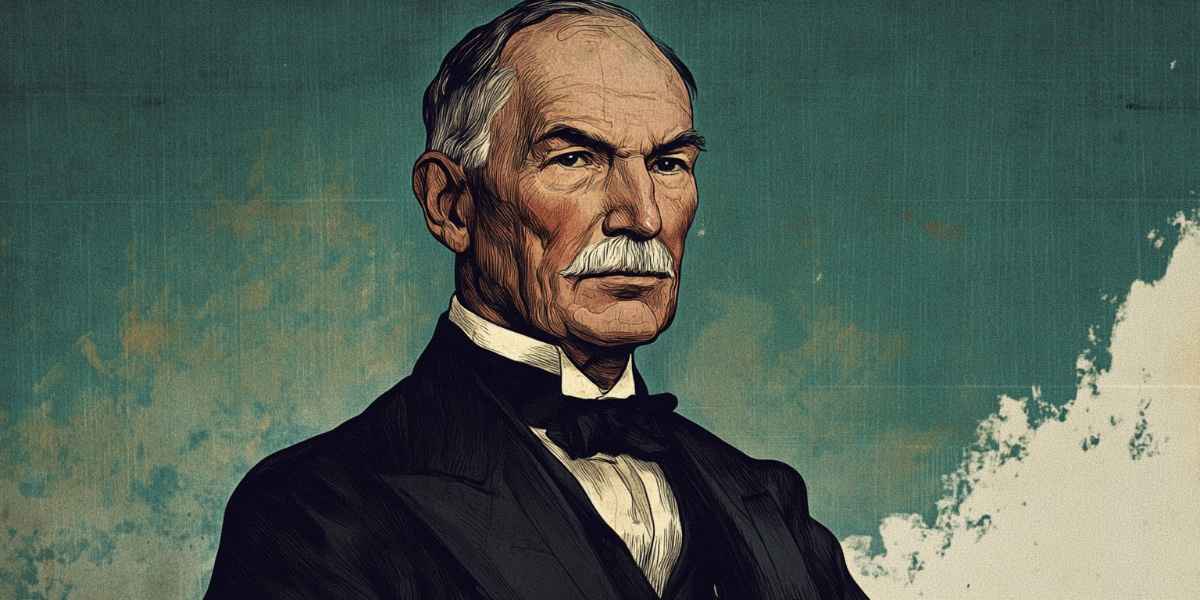The First Billionaire: The Rise and Influence of John D. Rockefeller

John D. Rockefeller, the first recorded billionaire in modern history, remains one of the most influential and controversial figures of the industrial age. His rise from modest beginnings to the helm of the world’s largest and most powerful oil empire is a testament to strategic brilliance, ruthless business practices, and an uncanny ability to exploit the rapidly expanding American economy. But Rockefeller’s legacy is not purely one of wealth and success. His methods, including monopolistic tactics, political influence, and the suppression of competition, have made him a subject of intense scrutiny and criticism.
Rockefeller’s dominance in the oil industry shaped not only the structure of modern capitalism but also the relationship between government and big business. His ability to amass unprecedented wealth allowed him to influence legislation, public policy, and even the shape of modern medicine and philanthropy. But the question remains: was Rockefeller’s fortune a product of visionary entrepreneurship or calculated exploitation? This article examines how Rockefeller amassed his fortune, the controversial strategies he employed, and the broader economic and political impact of his empire.
⸻
Early Life and Family Background
A Modest Beginning
John Davison Rockefeller was born on July 8, 1839, in Richford, New York, into a modest and complicated family. His father, William Avery Rockefeller, was a traveling salesman and self-styled “botanic physician” who sold dubious herbal remedies and lived a nomadic life. William was known for his dishonesty and shady business dealings, traits that would later be reflected, albeit in a more sophisticated form, in John D. Rockefeller’s business approach.
Rockefeller’s mother, Eliza Davison, was a devout Baptist who instilled in him a strict sense of morality and discipline. Eliza managed the household with a focus on frugality and religious devotion. According to Ron Chernow in Titan: The Life of John D. Rockefeller, Sr., Eliza would give John a penny for charitable donations, reinforcing the idea that wealth was both a responsibility and a blessing (Titan, Ron Chernow).
Education and Early Career
Despite his father’s unstable presence, Rockefeller showed an early aptitude for numbers and business. At the age of 16, he secured his first job as an assistant bookkeeper at Hewitt & Tuttle, a produce commission firm. He quickly distinguished himself through his meticulous attention to detail and shrewd financial sense.
Rockefeller’s first business venture came in 1859 when he partnered with Maurice Clark to open a produce business in Cleveland. That same year, oil was discovered in Titusville, Pennsylvania, triggering the nation’s first oil boom. Rockefeller immediately saw the potential for refining oil rather than drilling it, recognizing that refining offered higher margins and greater market control.
In 1863, Rockefeller and Clark built their first oil refinery in Cleveland. Within two years, it was the largest refinery in the region. Rockefeller bought out Clark’s share in 1865, marking the beginning of his complete control over the business. His focus on efficiency, cost-cutting, and controlling the supply chain laid the foundation for his future dominance in the oil industry.
⸻
The Rise of Standard Oil
Formation of Standard Oil
In 1870, Rockefeller co-founded the Standard Oil Company of Ohio with several partners, including his brother William Rockefeller and Henry Flagler. From the outset, Rockefeller pursued a strategy of aggressive consolidation and vertical integration, aimed at controlling every aspect of the oil production and distribution process.
Rockefeller realized that the refining stage was where the real money was made, as crude oil itself was a low-margin commodity. By refining oil into kerosene and lubricants, Rockefeller could control prices and supply chains, creating a profitable and defensible market position.
By the early 1870s, Standard Oil controlled about 10% of the U.S. refining capacity. But Rockefeller’s ambitions were far larger. Through a combination of calculated underpricing, secret deals with railroads, and the acquisition of smaller competitors, he began a campaign of market dominance that would transform Standard Oil into a monopoly.
Secret Railroad Rebates and Market Manipulation
One of Rockefeller’s most controversial tactics was negotiating secret rebates with railroad companies in exchange for guaranteed high-volume shipments of oil. These rebates allowed Standard Oil to transport oil at significantly lower costs than its competitors, driving many of them out of business.
Rockefeller also pioneered the use of “drawbacks,” which required railroads to pay Standard Oil a fee for transporting competitors’ oil. This ensured that even when competitors managed to ship oil, they were indirectly enriching Standard Oil (Titan, Ron Chernow).
Rockefeller’s rebate deals with railroads like the Pennsylvania Railroad and the Erie Railroad were a critical factor in Standard Oil’s dominance. According to Ida Tarbell, whose groundbreaking investigation into Standard Oil was published as The History of the Standard Oil Company (1904), Rockefeller’s secret agreements allowed him to undercut competitors and create an environment where Standard Oil’s dominance was unchallenged (The History of the Standard Oil Company, Ida Tarbell).
The South Improvement Company Scandal
In 1872, Rockefeller’s secret deals with the railroads were exposed in what became known as the South Improvement Company scandal. Rockefeller had formed a secret agreement with the major railroads, which gave Standard Oil exclusive rebates and forced competitors to pay higher rates.
Public outrage over the scheme led to political pressure and the eventual dissolution of the South Improvement Company. However, Rockefeller emerged stronger than ever. While the scandal temporarily disrupted his plans, it demonstrated the extent of his influence over American industry.
⸻
The Standard Oil Trust and Monopoly
Creation of the Standard Oil Trust
By 1882, Rockefeller consolidated his various holdings into the Standard Oil Trust, which controlled 90% of the U.S. oil refining industry. The trust structure allowed Rockefeller to bypass anti-monopoly laws by placing his various companies under the control of a central board of trustees.
This arrangement gave Rockefeller unparalleled control over the oil industry. He dictated prices, controlled supply chains, and even influenced global markets. Standard Oil’s dominance became so complete that it was effectively a state within a state, with its own infrastructure, transportation networks, and political influence.
Anti-Trust Pressure and the Supreme Court Case
Public and political pressure against Rockefeller’s monopoly grew steadily throughout the 1890s. The Sherman Antitrust Act was passed in 1890 in an attempt to curb the power of monopolies, but it was initially weakly enforced.
The turning point came in 1911, when the U.S. Supreme Court ruled that Standard Oil violated the Sherman Antitrust Act. The company was ordered to dissolve into 34 separate entities, including future oil giants like Exxon, Mobil, and Chevron (Standard Oil Broken Up by Federal Courts, New York Times).
Ironically, the breakup of Standard Oil increased Rockefeller’s wealth. He retained shares in the newly formed companies, which quickly appreciated in value as they dominated the post-breakup market.
⸻
Philanthropy and Reputation Management
Strategic Philanthropy
Despite his ruthless business practices, Rockefeller sought to craft a more benevolent public image through philanthropy. In 1892, he founded the University of Chicago, which quickly became one of the leading institutions of higher learning in the United States.
He also established the Rockefeller Foundation in 1913, which funded medical research, education, and public health initiatives around the world. According to Chernow, Rockefeller viewed philanthropy not only as a moral obligation but also as a strategic tool to reshape his public image and influence public policy (Titan, Ron Chernow).
Influence on Modern Medicine
Rockefeller’s influence on medicine was profound and controversial. The Flexner Report (1910), funded by the Rockefeller Foundation, led to the closure of many traditional medical schools and entrenched the dominance of allopathic, drug-centered medicine. Critics argue that this shift sidelined alternative and holistic approaches, establishing a medical-industrial complex focused on pharmaceutical profits (Medical Monopoly, Mary Morton).
⸻
Rockefeller’s Legacy
Enduring Economic and Political Influence
Rockefeller’s fortune, valued at $1.4 billion at the time of his death in 1937 (about $30 billion today), remains one of the largest in history. The companies formed from Standard Oil’s breakup continue to dominate the global energy sector. His descendants, through institutions like the Rockefeller Foundation, the Council on Foreign Relations, and their extensive holdings in finance and industry, have retained a powerful influence over global economic and political affairs. The Rockefeller name remains synonymous with both enormous wealth and the darker side of American capitalism — consolidation of power, corporate dominance, and political manipulation.
⸻
Conclusion
John D. Rockefeller’s rise to become the world’s first billionaire is a story of strategic brilliance, ruthless business tactics, and lasting influence. His model of corporate dominance laid the foundation for modern capitalism. Rockefeller’s legacy remains a complex mixture of economic innovation and monopolistic exploitation — a legacy that continues to shape the modern world.














